
If you have a newer computer that uses USB-C, this trustworthy flash drive is your best bet.
If you have a newer computer that uses USB-C, this trustworthy flash drive is your best bet.
Boasts 256GB storage capacity. All-metal design. Combines Lightning connector with USB-C connector. Transfers files over the USB-C connector at fast USB 3.0 speeds. iXpand app makes media and backup automatic and easy to use.
The dust cap is easy to lose or misplace.
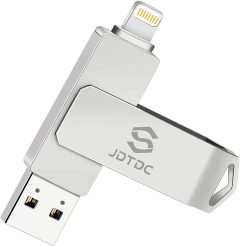
This MFi (Made for iPhone)-certified flash drive is a great value with essential features.
This MFi (Made for iPhone)-certified flash drive is a great value with essential features.
Handy 128GB capacity. Apple MFi-certified for compatibility with iOS devices with Lightning connector. Comes with USB-A connector with USB 3.0 transfer speeds. Compatible with a variety of media formats.
The app can be difficult to download.
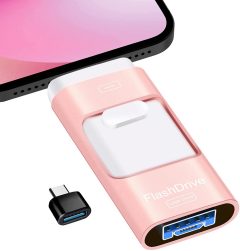
The convertible connector makes this cute little flash drive very useful and handy.
The convertible connector makes this cute little flash drive very useful and handy.
Compact all-in-1 connector offers USB-A, micro USB, and USB-C connections (with included adapter) in addition to Lightning. Aluminum shell for sturdiness. Offers 128GB of storage. App allows full drive encryption.
May be difficult to use without removing protective cases.
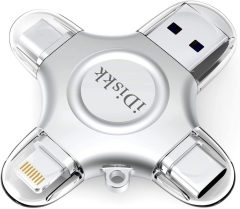
This versatile flash drive comes with a complete set of discrete connectors.
This versatile flash drive comes with a complete set of discrete connectors.
Four-connector design offers discrete, separate USB-A, Micro USB, USB-C, and Lightning connectors. Can be attached to a keychain. Provides 256 GB of external storage. MFi-certified compatible.
Some customers feel the app is inadequate.
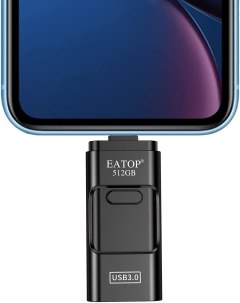
Safely and quickly store or transfer up to 512GB of data between smartphones, laptops, and other devices.
Safely and quickly store or transfer up to 512GB of data between smartphones, laptops, and other devices.
Coming in 3 distinct colors and being compatible with most mobile devices, this is one of the best methods of physically backing up or transferring data from mobile devices. Has a read speed of 80MB per second and a durable zinc alloy case.
Cannot be used with older Apple devices without corresponding adaptors. Connectors are shorter, so devices will likely need to be removed from any casing.

We recommend these products based on an intensive research process that's designed to cut through the noise and find the top products in this space. Guided by experts, we spend hours looking into the factors that matter, to bring you these selections.
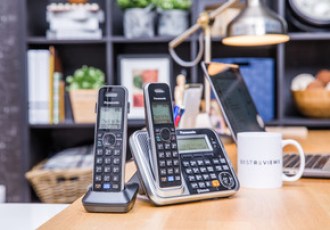
Your most prized commodity isn’t actually a phone – it's the data on it, like all the selfies, contacts, videos, and more. A phone can only hold so much data, though. Using a cloud service is an option, but you'll never be done paying for it because you're only renting the space. With an iPhone flash drive, that memory belongs to you.
The best iPhone flash drives are durable and compact (but not so small that they’re easily lost) and USB 3.0. The app that interfaces with your iPhone flash drive should be intuitive, easy to learn, and include security measures so that others won't be able to access your data.

Volatile memory needs an electrical charge to work. Think of your car – when your battery dies, your radio loses all the programmed stations. That's volatile memory. Flash drives use non-volatile memory, which keeps your data safe even without an electrical charge. There are two types of non-volatile memory used with an iPhone flash drive: a USB flash drive and an SD card.
USB flash drive: The latest USB flash drives (3.0) are faster than SD cards. Typically, they hold more data (but not always) and are universal – you can plug them into any USB port. (Note: An iPhone flash drive will connect to your phone using a Lightning connector, the crucial part that makes it an iPhone flash drive. The USB connector is used to connect the flash drive to a computer or other device that has a USB port.)




















Even though an iPhone flash drive is a tiny gadget, there are many features it may or may not have. You’ll need to carefully weigh each one of these options to decide if it’s one you need or one you can do without.
This is the third version of the Universal Serial Bus (USB) port. You would mainly want it for your iPhone flash drive because it transfers data ten times faster than USB 2.0. You can quickly tell if you have USB 3.0 because the inside of the connector is blue.
Your iPhone flash drive is only as good as the app that runs it. If it's intuitive and easy to use with one-tap controls, you'll be much happier than you would be if you had an awkwardly designed app that is complicated to learn.
iPhone flash drives come in a number of aesthetically pleasing, futuristic designs. You should pick the one you like, but only if there are no design flaws. For instance, don’t forsake durability for a thin, sleek, and fragile device or choose a flash drive that’s so small it's easily lost.
Besides simply being a flash drive for your iPhone, some units double as a charging cable. Cable break easily, so this feature could be handy.
An iPhone flash drive is going to get tossed about, so it needs to be sturdy enough to withstand the rigors of being constantly carried around.
The shield and contacts of USB and Lightning connectors need to be protected. iPhone flash drives do this in one of two ways. Retractable connectors slip inside the unit like a turtle's head and limbs into its shell. Dust covers work great, but they’re tiny and easily lost.
Some iPhone flash drives have several different connectors. While this may look cool, it's usually unnecessary. Typically a Lightning connector for your iPhone, a USB connector for your computer, and maybe a slot for an SD card are all you will need.
How much memory do you want? Is 32GB enough or do you need 128GB? When in doubt, it's usually wisest to spend a few extra dollars to have the additional memory.
If you misplace your iPhone flash drive, you'll want it protected so strangers can't get to your data. Password protection should be fine, but if you want to go the extra mile, some devices have touch ID that uses your fingerprint to gain access to the flash drive's contents.
If you’ll be using your iPhone flash drive to back up data from your camera, having a slot for an SD card is a desirable feature.
Unless you’re filming directly to your iPhone flash drive or constantly moving exceptionally large files, a slightly slower speed will likely be little more than a minor inconvenience.
If you want to bypass physical connections, there are a few wireless iPhone flash drives on the market. However, most of these are not as highly recommended as the wired models.

The overall price range for iPhone flash drives extends from $10 to $60. Although there are some outliers, the price is most closely related to the amount of memory the flash drive has.
32GB flash drives cost about $15 to $25.
64GB flash drives cost about $25 to $40.
128GB flash drives cost about $40 to $60.
Although devices and apps differ, there is a basic connection process that is similar for all iPhone flash drives. The following are three simple steps that will get you up and running.
Download the appropriate app to your iPhone. For instance, if you have a Kingston flash drive, you’ll need to download and install the Kingston Bolt app.
Plug in your iPhone flash drive. Yes, it’s as easy as it sounds – just plug your flash drive into your iPhone.

A. Your flash drive is likely fine. iPhones are stingy with the data that you can see and back up. Mostly, it will be media files like photos, videos, and audio files. However, if you’re running the latest iOS, you might be able to back up a few other bits of data that you can find in the Files app. You also may be able to back up your contact data depending on the abilities of the app.
A. That depends on if the data transfer rate is fast enough to keep up. If not, you’ll either have to get a faster iPhone flash drive or try shooting your video at a lower resolution. Taking pictures directly to your flash drive, however, shouldn’t be a problem.
A. Again, it depends on the app. The photos on your social media accounts don’t have to be on your iPhone. By granting certain apps access to your social media accounts, they can back up the photos you may no longer have on your iPhone.
Get emails you’ll love.
Learn about the products you’re wondering if you should buy and get advice on using your latest purchases.
